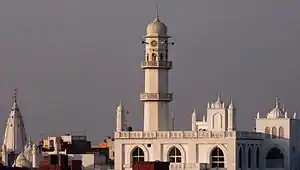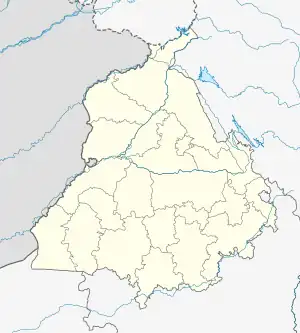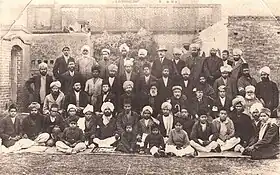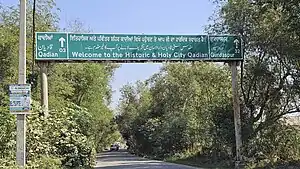Qadian | |
|---|---|
City | |
 Minaret-ul-Masih of Aqsa Mosque located alongside a Mandir and Gurudwara is one of the major landmarks of Qadian | |
 Qadian Location in Punjab, India  Qadian Qadian (India) | |
| Coordinates: 31°49′09″N 75°22′35″E / 31.81917°N 75.37639°E | |
| Country | |
| State | Punjab |
| District | Gurdaspur |
| Elevation | 250 m (820 ft) |
| Population (2013)[1] | |
| • Total | 40,827 |
| Languages | |
| • Official | Punjabi |
| Time zone | UTC+5:30 (IST) |
Qadian (Punjabi pronunciation: [käːd̪ijä̃ː]; Hindustani pronunciation: [qɑːd̪ijɑ̃ːn]) is a city and a municipal council in Gurdaspur district, north-east of Amritsar, situated 18 kilometres (11 mi) north-east of Batala city in the state of Punjab, India. Qadian is the birthplace of Mirza Ghulam Ahmad, the founder of the Ahmadiyya movement within Islam. It remained the headquarters of the Ahmadiyya movement until the Partition of India in 1947.
History
Qadian was established in 1530 by Mirza Hadi Baig, a religious scholar dedicated to Islam and the first Qazi in the area. Mirza Hadi Baig was from a royal household of Mirza of the Mughal Empire. He migrated from Samarkand and settled in Punjab where he was granted a vast tract of land comprising 80 villages by the emperor Babur. Because of his religious beliefs, he named the center of the 80 villages Islam Pur Qazi and governed from there. Over time, the name of the town changed to Qazi Maji, then Qadi, and eventually it became known as 'Qadian'.
Qadian and the surrounding areas later fell to the Ramgarhia Sikhs under the leadership of Jassa Singh Ramgarhia who offered the ruling Qazis, two villages which they refused. In 1834, during the rule of Maharaja Ranjit Singh, the region consisting of Qadian and five adjoining villages was given to Mirza Ghulam Murtaza, father of Ghulam Ahmad in return for military support in Kashmir, Mahadi, the Kulu valley, Peshawar and Hazara.[2]

As the home of the Ahmadiyya Movement
A remote and unknown town, Qadian emerged as a centre of religious learning in 1889, when Mirza Ghulam Ahmad established the Ahmadiyya Muslim Community.[3] In 1891 it became the venue for the Community's annual gatherings. Qadian remained the administrative headquarters and capital of the Ahmadiyya Caliphate until the partition of India in 1947, when much of the Community migrated to Pakistan. Following the partition, Mirza Bashir-ud-Din Mahmud Ahmad, the second Khalifa of the Community, carefully oversaw the safe migration of Ahmadis from Qadian to the newly founded state, instructing 313 men, including two of his own sons, to stay in Qadian and guard the sites holy to Ahmadis, conferring upon them the title darveshān-i qādiyān (the dervishes of Qadian) and eventually moving the headquarters to Rabwah, Pakistan.[4]
Geography
Qadian is located at 31°49′N 75°23′E / 31.82°N 75.39°E. It has an average elevation of 250 metres (820 feet).[5][6]
Demographics

Qadian has a population of 23,632.[7] Males constituted 54% of the population and females 46%. Qadian has an average literacy rate of 75%, slightly higher than the national average of 74.04%: male literacy is 78%, and female literacy is 70%. 10% of the population is under 6 years of age.[8]
Languages
Most of the residents of Qadian are speakers of the Punjabi language. A significant minority, about a 1/10 of the population, also speak the Urdu language. In areas like Mohallah Ahmadiyya, Urdu signs are a common sight.
Languages by the number of speakers in Qadian according to the 2011 Census of India
Religion
Hinduism is the largest religion in Qadian, with significant populations of the adherents of Sikhism and Islam.[9]
The table below shows the population of different religious groups in Qadian city and their gender ratio, as of 2011 census.
| Religion | Total | Female | Male | Gender ratio |
|---|---|---|---|---|
| Hindu | 12,263 | 5,764 | 6,499 | 886 |
| Sikh | 7,431 | 3,599 | 3,832 | 939 |
| Muslim | 3,065 | 1,312 | 1,753 | 748 |
| Christian | 788 | 375 | 413 | 907 |
| Jain | 2 | 0 | 2 | -- |
| Other religions | 13 | 6 | 7 | 857 |
| Not stated | 70 | 27 | 43 | 627 |
| Total | 23,632 | 11,083 | 12,549 | 883 |
Islam
Today in Qadian, there are 11 mosques belonging to the Ahmadiyya community most of which date before the partition. Initially the majority of the mosques were based on the Urdu neighbourhood names (with the exception of Aqsa Mosque and Mubarak Mosque), but many have been renamed, following their renovation in 2012.[11]
- Aqsa Mosque (1876)
- Mubarak Mosque (1883)
- Noor Mosque (1910)
- Nasirabad Mosque (1913)
- Fazl Mosque (1914)
- Rahman Mosque (1927)
- Subhan Mosque (1935)
- Mumtaz Mosque (1936)
- Anwaar Mosque (1939)
- Masroor Mosque (2015)
Further, three mosques existed prior to the partition, but have since been occupied, namely:[11]
- Darul Fazl Mosque
- Darus Sa'at Mosque
- Starhousry Factory Mosque
Outside of Qadian, in the neighbouring areas, an additional four mosques of Kahlwan and Nangal Bagbana exist, namely:[11]
| Name | Year | Area |
|---|---|---|
| Tahir Mosque | 1997 | Nangal |
| Basharat Mosque | Pre-partition | |
| Mehdi Mosque | 2004 | Kahlwan |
| Mahmood Mosque | 2012 |
Politics
The city is part of the Qadian Assembly Constituency.
Notable monuments
Hospitals
Education
Sikh National College (Lahore). It was transferred to Qadian during partition
Notable people
.jpg.webp)
Although Qadian is relatively remote and has a very small population, it has many notable historical, religious and political figures;
Religious Leaders
Ahmadiyya Caliphs
- Hakeem Noor-ud-Din from 1908 to 1914
- Mirza Basheer-ud-Din Mahmood Ahmad from 1914 to 1965
- Mirza Nasir Ahmad from 1965 to 1982
- Mirza Tahir Ahmad from 1982 to 2003
Poets
Military Leaders
Politicians
References
- ↑ "Census of India 2001: Data from the 2001 Census, including cities, villages and towns (Provisional)". Census Commission of India. Archived from the original on 16 June 2004. Retrieved 1 November 2008.
- ↑ Shahid, Dost Mohammad (2007) [2000]. Taareekhe–Ahmadiyyat (Tareekh E Ahmadiyyat) [History of Ahmadiyyat] (PDF) (in Urdu). Vol. 1. India: Nazarat Nashro Ishaat Qadian. p. 40. ISBN 978-81-7912-121-4. ISBN incorrectly printed in the book as 181-7912-121-6. Complete PDF: 19 Volumes (11,600 pages) (541.0 M). (Volume 14 meta-data appeared to closely match the original reference, but is unverified as the correct volume).
- ↑ Kobeisy 2004, p. 44.
- ↑ Khan, Adil Hussain (6 April 2015). From Sufism to Ahmadiyya: A Muslim Minority Movement in South Asia. ISBN 9780253015297. Archived from the original on 10 February 2020. Retrieved 20 September 2015.
- ↑ "Qadian in India is Situated Exactly to the East of Damascus in Syria". Flickr. 16 February 2009. Archived from the original on 8 January 2017. Retrieved 3 July 2009.
- ↑ "The Divine guidance about leadership in the latter days". Ahmaddiya Muslim Community. 16 February 2009. Archived from the original on 8 January 2017. Retrieved 3 July 2009.
- ↑ "Religion PCA" (PDF). Census India. Office of the Registrar General & Census Commissioner, India. Retrieved 8 February 2022.
- ↑ "Census of India 2001: Data from the 2001 Census, including cities, villages and towns (Provisional)". Census Commission of India. Archived from the original on 16 June 2004. Retrieved 1 November 2008.
- ↑ "Religion PCA" (PDF). Census India. Office of the Registrar General & Census Commissioner, India. Retrieved 8 February 2022.
- ↑ https://censusindia.gov.in/nada/index.php/catalog/11389, India - C-01: Population by religious community, Punjab - 2011, Qadian (M Cl + OG)
- 1 2 3 "قادیان دارالامان کی چند مساجد کا تعارف" [A brief introduction of some mosques in Qadian]. Daily Alfazl Online (in Urdu). 30 December 2022. Retrieved 14 September 2023.
Bibliography
- Kobeisy, Ahmed Nezar (2004). Counseling American Muslims: Understanding the Faith and Helping the People. Greenwood Publishing Group. ISBN 9780313324727.
External links
 Media related to Qadian at Wikimedia Commons
Media related to Qadian at Wikimedia Commons